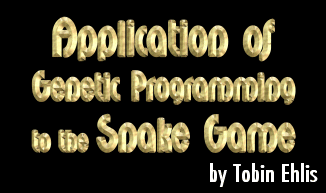11/10 - 11/12 @ Montréal, Canada
12/5 - 12/7 @ Shanghai, China
12/24 - 12/27
2/28 - 3/4 @ San Francisco, CA
More events...
2406 articles in the reference section.
Help us fight cancer!
Join SETI Team GDNet!

|
ConclusionThis paper has presented the development and evaluation of a function set capable of evolving an optimal solution to the snake game. An initial function set was presented and evaluated, but proved unsuccessful at evolving an optimal solution. The initial function set was then expanded upon to create the successful final function set, and consistently optimal solutions were generated using primed GP runs. A comparison was made of the results achieved by each function set, as well as by the primed GP runs. Examples of commonly evolved strategies were presented and evaluated, and a final analysis of a consistently successful optimal solution was given. Future WorkThe work presented in this paper provides innumerable opportunities for further investigation into the evolution of a task prioritization scheme within a dynamically changing, randomly updated environment. Specific to the snake problem, modifications can be made to create completely new and interesting problems, such as a non-rectangular game board, obstacles within the game board, or multiple pieces of food. Multiple snakes could be co-evolved to competitively pursue the food. The function set could be modified to feature enhanced detection capabilities and more advanced navigational options. The techniques used for navigating the snake could be generalized to apply to various other problems of interest. Possibilities include automated navigation of multiple robots through a crowded workspace, an automaton for tracking fleeing police suspects through harsh environments, or a control scheme for an exploratory vehicle seeking a particular goal on a harsh alien planet. The possibilities are only limited by the imagination. ReferencesKoza, John R. 1992. Genetic Programming: On the Programming of Computers by Means of Natural Selection. Cambridge, Massachusetts: The MIT Press. |
|||||||||||